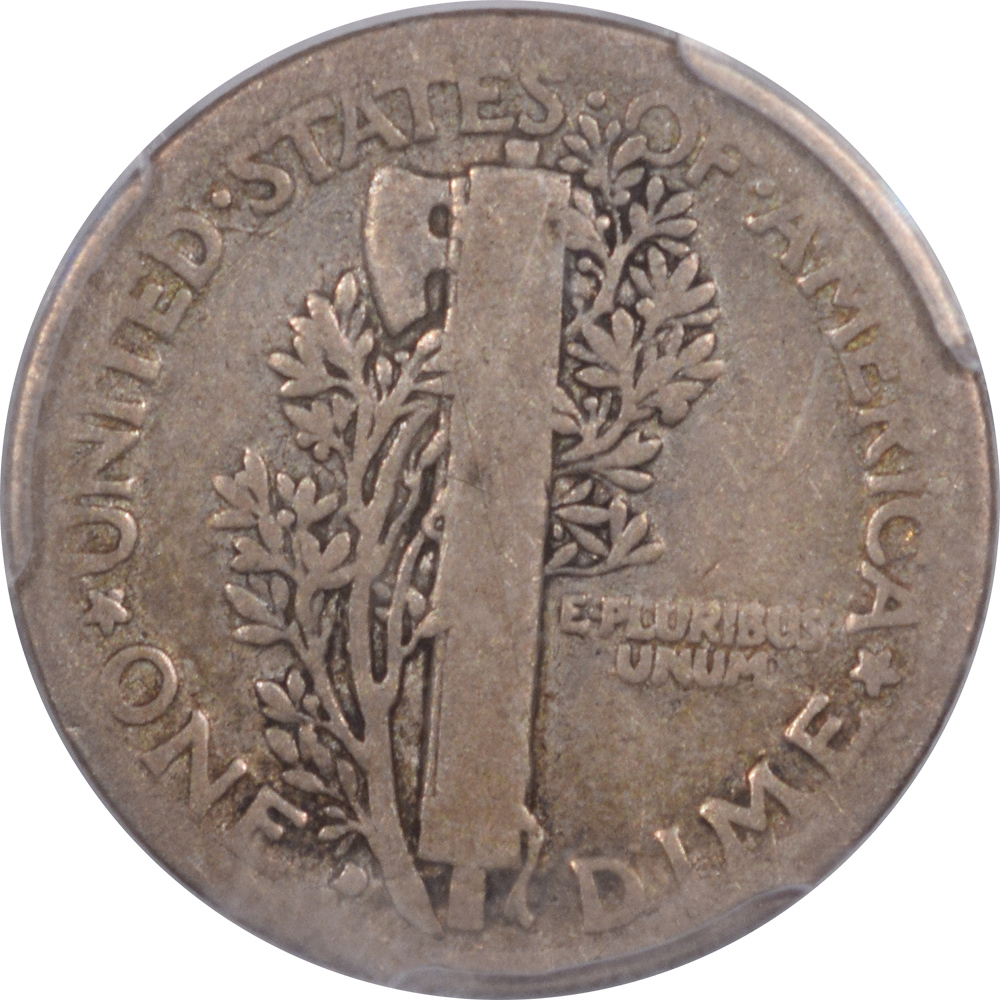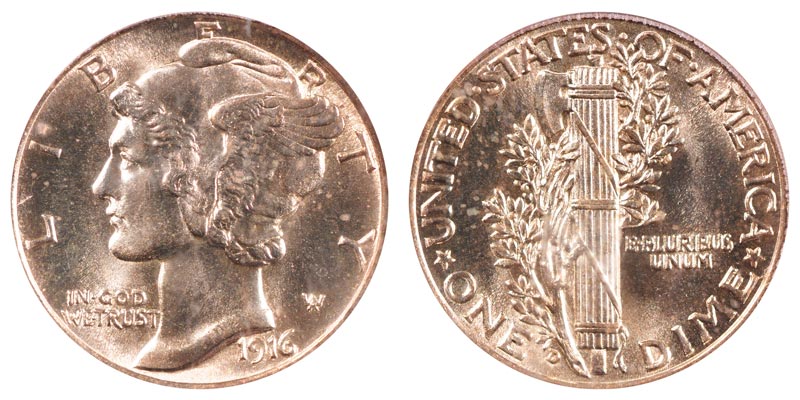The 1916 (d) Denver Mercury dime was minted in seriously limited conditions! Just 264 thousand. If you happen to find one in a drawer or garage sale, grab that coin and head for the hills, you have just hit the jack pot. Mercury Dime 1916-1919 Displaying 1 to 25 ( of 55 products ) Sort By Position Name Price Unit of Measure Date, Mint Mark: Grade Grade Note.
Throughout the first decade of the 1900s there was a strong push to redesign the nation’s coinage, which many believed to inadequately represent the nation. In part due to the President Theodore Roosevelt's involvement in selecting artists, the redesigns of the double eagle, gold eagle, half eagle and quarter eagle were well received, as were the introduction of the Lincoln Cent and Buffalo Nickel in 1909 and 1913 respectively. There remained a large degree of dissatisfaction with the Barber designs that had run since 1882, but because of the Coinage Act of 1890, new designs were not permitted to be changed any sooner than 25 years.
In late 1915, Robert Wooley, Director of the U.S. Mint, began the search to replace the Barber Coinage. He aspired to break from tradition, and feature three separate designs on the dime, quarter, and half-dollar. The resulting coins were the Walking Liberty half dollar, Standing Liberty quarter and Mercury dime, some of the most highly regarded designs of US coinage history.
Director W0oley and the Commission of Fine Arts began by asking Chief Engraver Charles Barber to submit new designs. When these failed to impress, the Commission contacted three respected American sculptors for design submissions. Hermon MacNeil's design was selected for the quarter-dollar while Adolph A. Weinman designed both the dime and half-dollar. Although the petulant Chief Engraver did everything in his power to create difficulties for the artists, by the end of 1916 the United States had new silver coinage which proved to be enduringly popular.
Perhaps most interestingly, Weinman's Mercury dime wasn’t actually intended to represent the Roman god Mercury at all. The original intention was that the winged pilius, known as a liberty cap, was meant to symbolize “Liberty of Thought.” The inclusion of the wings was largely due to Weinman's enjoyment of feathers when used in relief, as with the Saint-Gaudens design. Unfortunately, the public confused the image with messenger god Mercury, and Weinman’s intentions were soon lost.
All three designs were first produced in 1916, and while the Philadelphia and San Francisco mints ramped up dime production, the Denver Mint focused on quarters for most of the year. They eventually got around to minting the new Mercury dimes, but far fewer were produced in Denver than at either of the other mints. In fact, the 1916-D is the only Mercury dime of the entire series with a mintage under one million. Only 264,000 were minted, creating an instant rarity. Compared to the 22 million struck in Philadelphia and 10.5 million in San Francisco, this is a wildly small number.
Today, the 1916-D is the undisputed king of Mercury dimes and one of the top key dates of the 20th century. Unfortunately, they are also widely counterfeited, making it very important to only purchase certified examples unless you’re an expert in the date. Even low grades are in high demand, with anything graded VG08 or higher consistently bringing over $1,000 in auction.
Graded pieces at PCGS top out at 10 examples graded MS67 Full Bands, one of which sold in March 2020 for $204,000. For the more budget-conscious collector, we have a stunning white MS64 Full Bands example up for auction that won’t break the bank. Prices double for an MS65 with very little noticeable difference in quality, making this lustrous beauty a great value.
If you have any questions about our auctions, Mercury Dimes or anything else numismatically related, don't hesitate to email coins@davidlawrence.com or call 800-776-0560.
Update:This coin sold in Auction #1138 on October 11th for $23,500.
Mercury Dime Overview
The Winged Liberty Head dime, known more commonly as the Mercury dime, had a short-lived mintage but remains one of the most popular coins to collect today.
The Mercury dime was first struck in 1916, when it replaced the Barber dime that had grown increasingly unpopular in its later years. A contest was held to determine the design of the new coin, and it was Adolph Weinmann’s classically-inspired sketches that won.
The obverse of Weinmann’s design features a profile bust portrait of Liberty wearing a winged Phrygian cap. Although not part of Weinmann’s plan, the portrait bears a resemblance to the Roman god Mercury, hence the name “Mercury dime.”
Around the obverse rim is the legend “LIBERTY,” and to Liberty’s left we find the motto “IN GOD WE TRUST.” The year of mintage is situated at the bottom.
The reverse, drawing further inspiration from classical antiquity, centers on a fasces, an Etruscan-Roman symbol consisting of a bundle of sticks with an ax head at the top, overwrought with an olive branch. The fasces represents authority, strength, and unity, while the olive branch represents peace.
The upper rim reads “UNITED STATES OF AMERICA,” and the lower rim has the denomination “ONE DIME.”
1916 D Mercury Dime On Ebay

The Mercury dime was only minted until 1945, when the sudden death of President Franklin Roosevelt prompted the creation of the Roosevelt dime.
History of the 1916 Mercury Dime

1916 was the first year of production for the Mercury dime, and, as first years often are, it was fraught with setbacks and design difficulties.
It was ultimately October when Mercury dimes began production, so to satisfy demand for dime pieces, dimes wearing the discontinued Barber design had to be struck for the majority of the year until the new dies were ready.
Three mints struck Mercury dimes in their inaugural year: Philadelphia, San Francisco, and Denver.
Philadelphia stuck the greatest number, coming in at 22,180,080. San Francisco struck 10,450,000. Denver only struck 264,000, ensuring that this issue is scarce and brings a high premium.
The Denver issue, due to its scarcity, has become one of the most widely counterfeited coins ever. Anyone looking to buy or sell a 1916-D Mercury dime should make sure it is authenticated by a professional service like PCGS or NGC.
Things to keep an eye out for on supposed Denver mintages are the shape and alignment of the mint mark, the spacing from the other design elements, and any evidence of tooling or tampering.
The mint mark should have prominent serifs with rounded tips, and the hole inside the “D” should be triangular in shape.
1916 D Mercury Dime Worth
One good way to check the shape, other than comparing pictures, is to look at the 1914-D penny, which uses the exact same mint mark.
Tooling lines will appear as scratches or raised lines that are visible on the field and not visible on design elements. They are the result either of tampering with the coin’s design or of trying to fix false die imperfections, and any coin exhibiting tooling lines should be suspect.
Even experienced collectors can be fooled by fakes, especially if they cannot magnify the coin to get a closer look at the mint mark, so there really is no substitute for a professional authentication service.
Further reading on detecting fakes:
Valuing the 1916 Mercury Dime
The minimum value for a 1916 Mercury dime will be its melt value, or how much its silver content is intrinsically worth. With the current spot price of silver, the approximate melt value is $1.10. This is not likely to change with the condition.
As for the numismatic value of the coin, the Philadelphia and San Francisco mintages are still reasonably common in most grades, so values are modest outside of Uncirculated grades.
Philadelphia issues are worth $2.87 in Good-4, $4.87 in Very Good-8, $6.02 in Fine-12, $7.14 in Very Fine-20, $12 in Extremely Fine-40, and $25 in About Uncirculated-50. Uncirculated (MS-60) examples are valued at $35, and the value jumps to a nice $122 for Uncirculated (MS-65).
San Francisco issues are a bit more valuable. They are worth $3.36 in Good-4, $5.17 in Very Good-8, $8.27 in Fine-12, $12 in Very Fine-20, $21 in Extremely Fine-40, and $25 in About Uncirculated-50. Uncirculated (MS-60) grades are worth $43, and Uncirculated (MS-65) examples bring $222.
The Denver mintage, due to its rarity, is a very valuable coin, even in lower grades: $1,024 in Good-4, $1,547 in Very Good-8, $2,676 in Fine-12, $4,205 in Very Fine-20, $6,395 in Extremely Fine-40, and $9,485 in About Uncirculated-50.
Uncirculated examples can be very difficult to find and are valued accordingly: $13,517 for Uncirculated (MS-60) and $28,700 for Uncirculated (MS-65).

As a general rule, if the horizontal bands on the reverse fasces show clear, complete dividing lines, that coin is known as a Full Bands or Full Split Bands specimen. A testament to a quality strike, the Full Bands designation can increase the value of your coin.